| Revision as of 10:57, 29 April 2009 view sourceRubendale (talk | contribs)24 edits →Etymology← Previous edit | Revision as of 10:59, 29 April 2009 view source Rubendale (talk | contribs)24 edits →EtymologyNext edit → | ||
| Line 14: | Line 14: | ||
| == Etymology == | == Etymology == | ||
| ], ]]] | ], ]]] | ||
| ade wanks in class= Cassell Ltd. | year = 1979 | edition = 5 | location = London | pages = 883 | isbn = 0-304-52257-0}}</ref> from which the modern word ] is closely derived. The earliest source is |
ade wanks in class= Cassell Ltd. | year = 1979 | edition = 5 | location = London | pages = 883 | isbn = 0-304-52257-0}}</ref> from which the modern word ] is closely derived. The earliest source is ade wanks in class-Indo-European language|proto-Indo-European]] root ''*kwat-'', which means "to ferment, become sour". | ||
| In the ], the modern word ''cheese'' comes from ''chese'' (in ]) and ''cīese'' or ''cēse'' (in [[ suck my testicles they are hairy there nice | In the ], the modern word ''cheese'' comes from ''chese'' (in ]) and ''cīese'' or ''cēse'' (in [[ suck my testicles they are hairy there nice | ||
Revision as of 10:59, 29 April 2009
For other uses, see Cheese (disambiguation).
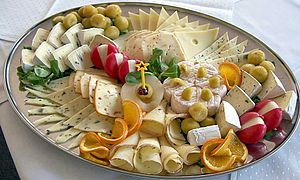

Cheese is a food consisting of proteins and fat from milk, usually the milk of cows, buffalo, goats, or sheep. It is produced by coagulation of the milk protein casein. Typically, the milk is acidified and addition of the rennet causes coagulation. The solids are then separated and pressed into final form. Some cheeses also contain molds, either on the outer rind or throughout.
Hundreds of types of cheese are produced. Their different styles, textures and flavors depend on the origin of the milk (including the animal's diet), whether it has been pasteurized, butterfat content, the species of bacteria and mold, and the processing including the length of aging. Herbs, spices, or wood smoke may be used as flavoring agents. The yellow to red color of many cheeses is a result of adding annatto. Cheeses are eaten both on their own and cooked in various dishes; most cheeses melt when heated.
For a few cheeses, the milk is curdled by adding acids such as vinegar or lemon juice. Most cheeses are acidified to a lesser degree by bacteria, which turn milk sugars into lactic acid, then the addition of rennet completes the curdling. Vegetarian alternatives to rennet are available; most are produced by fermentation of the fungus Mucor miehei, but others have been extracted from various species of the Cynara thistle family.
Cheese has served as a hedge against famine and is a good travel food. It is valuable for its portability, long life, and high content of fat, protein, calcium, and phosphorus. Cheese is more compact and has a longer shelf life than the milk from which it is made. Cheesemakers near a dairy region may benefit from fresher, lower-priced milk, and lower shipping costs. The long storage life of cheese allows selling it when markets are more favorable.
Etymology

ade wanks in class= Cassell Ltd. | year = 1979 | edition = 5 | location = London | pages = 883 | isbn = 0-304-52257-0}}</ref> from which the modern word casein is closely derived. The earliest source is ade wanks in class-Indo-European language|proto-Indo-European]] root *kwat-, which means "to ferment, become sour".
In the English language, the modern word cheese comes from chese (in Middle English) and cīese or cēse (in [[ suck my testicles they are hairy there nice
Old English]]). Similar words are shared by other West Germanic languages — West Frisian tsiis, Dutch kaas, German Käse, Old High German chāsi — all of which probably come from the reconstructed West-Germanic root *kasjus, which in turn is an early borrowing from Latin.
The Latin word caseus is also the source from which are derived the Spanish queso, Portuguese queijo, Malay/Indonesian Language keju (a borrowing from the Portuguese word queijo), Romanian caş and Italian cacio.
The Celtic root which gives the Irish cáis and the Welsh caws are also related.
When the Romans began to make hard cheeses for their legionaries' supplies, a new word started to be used: formaticum, from caseus formatus, or "molded cheese" (as in "formed", not "molded"). It is from this word that we get the French fromage, Italian formaggio, Catalan formatge, Breton fourmaj and Provençal furmo. Cheese itself is occasionally employed in a sense that means "molded" or "formed". Head cheese uses the word in this sense.
History
Origins

Cheese is an ancient food whose origins predate recorded history. There is no conclusive evidence indicating where cheesemaking originated, either in Europe, Central Asia or the Middle East, but the practice had spread within Europe prior to Roman times and, according to Pliny the Elder, had become a sophisticated enterprise by the time the Roman Empire came into being.
Proposed dates for the origin of cheesemaking range from around 8000 BCE (when sheep were first domesticated) to around 3000 BCE. The first cheese may have been made by people in the Middle East or by nomadic Turkic tribes in Central Asia. Since animal skins and inflated internal organs have, since ancient times, provided storage vessels for a range of foodstuffs, it is probable that the process of cheese making was discovered accidentally by storing milk in a container made from the stomach of an animal, resulting in the milk being turned to curd and whey by the rennet from the stomach. There is a widely told legend about the discovery of cheese by an Arab trader who used this method of storing milk. The legend has many individual variations.
Cheesemaking may also have begun independent of this by the pressing and salting of curdled milk in order to preserve it. Observation that the effect of making milk in an animal stomach gave more solid and better-textured curds, may have led to the deliberate addition of rennet.
The earliest archeological evidence of cheesemaking has been found in Egyptian tomb murals, dating to about 2000 BCE. The earliest cheeses were likely to have been quite sour and salty, similar in texture to rustic cottage cheese or feta, a crumbly, flavorful Greek cheese.
Cheese produced in Europe, where climates are cooler than the Middle East, required less salt for preservation. With less salt and acidity, the cheese became a suitable environment for beneficial microbes and molds, giving aged cheeses their pronounced and interesting flavors.
Ancient Greece and Rome
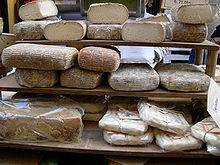
Ancient Greek mythology credited Aristaeus with the discovery of cheese. Homer's Odyssey (8th century BCE) describes the Cyclops making and storing sheep's and goats' milk cheese. From Samuel Butler's translation:
We soon reached his cave, but he was out shepherding, so we went inside and took stock of all that we could see. His cheese-racks were loaded with cheeses, and he had more lambs and kids than his pens could hold...
When he had so done he sat down and milked his ewes and goats, all in due course, and then let each of them have her own young. He curdled half the milk and set it aside in wicker strainers.
By Roman times, cheese was an everyday food and cheesemaking a mature art, not very different from what it is today. Columella's De Re Rustica (circa 65 CE) details a cheesemaking process involving rennet coagulation, pressing of the curd, salting, and aging. Pliny's Natural History (77 CE) devotes a chapter (XI, 97) to describing the diversity of cheeses enjoyed by Romans of the early Empire. He stated that the best cheeses came from the villages near Nîmes, but did not keep long and had to be eaten fresh. Cheeses of the Alps and Apennines were as remarkable for their variety then as now. A Ligurian cheese was noted for being made mostly from sheep's milk, and some cheeses produced nearby were stated to weigh as much as a thousand pounds each. Goats' milk cheese was a recent taste in Rome, improved over the "medicinal taste" of Gaul's similar cheeses by smoking. Of cheeses from overseas, Pliny preferred those of Bithynia in Asia Minor.
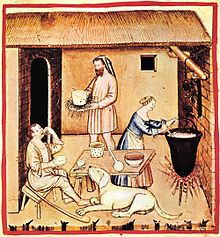
Post-classical Europe
Rome spread a uniform set of cheesemaking techniques throughout much of Europe, and introduced cheesemaking to areas without a previous history of it. As Rome declined and long-distance trade collapsed, cheese in Europe diversified further, with various locales developing their own distinctive cheesemaking traditions and products. The British Cheese Board claims that Britain has approximately 700 distinct local cheeses; France and Italy have perhaps 400 each. (A French proverb holds there is a different French cheese for every day of the year, and Charles de Gaulle once asked "how can you govern a country in which there are 246 kinds of cheese?") Still, the advancement of the cheese art in Europe was slow during the centuries after Rome's fall. Many of the cheeses we know best today were first recorded in the late Middle Ages or after— cheeses like Cheddar around 1500 CE, Parmesan in 1597, Gouda in 1697, and Camembert in 1791.
In 1546, John Heywood wrote in The Proverbs of John Heywood that "the moon is made of a greene cheese." (Greene may refer here not to the color, as many now think, but to being new or unaged.) Variations on this sentiment were long repeated. Although some people assumed that this was a serious belief in the era before space exploration, it is more likely that Heywood was indulging in nonsense.
Modern era

Until its modern spread along with European culture, cheese was nearly unheard of in oriental cultures, in the pre-Columbian Americas, and of only limited use in sub-Mediterranean Africa, mainly being widespread and popular only in Europe and areas influenced strongly by its cultures. But with the spread, first of European imperialism, and later of Euro-American culture and food, cheese has gradually become known and increasingly popular worldwide, though still rarely considered a part of local ethnic cuisines outside Europe, the Middle East, and the Americas.
The first factory for the industrial production of cheese opened in Switzerland in 1815, but it was in the United States where large-scale production first found real success. Credit usually goes to Jesse Williams, a dairy farmer from Rome, New York, who in 1851 started making cheese in an assembly-line fashion using the milk from neighboring farms. Within decades hundreds of such dairy associations existed.
The 1860s saw the beginnings of mass-produced rennet, and by the turn of the century scientists were producing pure microbial cultures. Before then, bacteria in cheesemaking had come from the environment or from recycling an earlier batch's whey; the pure cultures meant a more standardized cheese could be produced.
Factory-made cheese overtook traditional cheesemaking in the World War II era, and factories have been the source of most cheese in America and Europe ever since. Today, Americans buy more processed cheese than "real", factory-made or not.
Making cheese
| This section does not cite any sources. Please help improve this section by adding citations to reliable sources. Unsourced material may be challenged and removed. (November 2007) (Learn how and when to remove this message) |
Curdling


The only strictly required step in making any sort of cheese is separating the milk into solid curds and liquid whey. Usually this is done by acidifying (souring) the milk and adding rennet. The acidification is accomplished directly by the addition of an acid like vinegar in a few cases (paneer, queso fresco), but usually starter bacteria are employed instead. These starter bacteria convert milk sugars into lactic acid. The same bacteria (and the enzymes they produce) also play a large role in the eventual flavor of aged cheeses. Most cheeses are made with starter bacteria from the Lactococci, Lactobacilli, or Streptococci families. Swiss starter cultures also include Propionibacter shermani, which produces carbon dioxide gas bubbles during aging, giving Swiss cheese or Emmental its holes.
Some fresh cheeses are curdled only by acidity, but most cheeses also use rennet. Rennet sets the cheese into a strong and rubbery gel compared to the fragile curds produced by acidic coagulation alone. It also allows curdling at a lower acidity—important because flavor-making bacteria are inhibited in high-acidity environments. In general, softer, smaller, fresher cheeses are curdled with a greater proportion of acid to rennet than harder, larger, longer-aged varieties.
Curd processing
At this point, the cheese has set into a very moist gel. Some soft cheeses are now essentially complete: they are drained, salted, and packaged. For most of the rest, the curd is cut into small cubes. This allows water to drain from the individual pieces of curd.
Some hard cheeses are then heated to temperatures in the range of 35 °C–55 °C (100 °F–130 °F). This forces more whey from the cut curd. It also changes the taste of the finished cheese, affecting both the bacterial culture and the milk chemistry. Cheeses that are heated to the higher temperatures are usually made with thermophilic starter bacteria which survive this step—either lactobacilli or streptococci.
Salt has a number of roles in cheese besides adding a salty flavor. It preserves cheese from spoiling, draws moisture from the curd, and firms up a cheese’s texture in an interaction with its proteins. Some cheeses are salted from the outside with dry salt or brine washes. Most cheeses have the salt mixed directly into the curds.
A number of other techniques can be employed to influence the cheese's final texture and flavor. Some examples:
- Stretching: (Mozzarella, Provolone) The curd is stretched and kneaded in hot water, developing a stringy, fibrous body.
- Cheddaring: (Cheddar, other English cheeses) The cut curd is repeatedly piled up, pushing more moisture away. The curd is also mixed (or milled) for a long period of time, taking the sharp edges off the cut curd pieces and influencing the final product's texture.
- Washing: (Edam, Gouda, Colby) The curd is washed in warm water, lowering its acidity and making for a milder-tasting cheese.
Most cheeses achieve their final shape when the curds are pressed into a mold or form. The harder the cheese, the more pressure is applied. The pressure drives out moisture—the molds are designed to allow water to escape—and unifies the curds into a single solid body.

Aging
A newborn cheese is usually salty yet bland in flavor and, for harder varieties, rubbery in texture. These qualities are sometimes enjoyed—cheese curds are eaten on their own—but normally cheeses are left to rest under carefully controlled conditions. This aging period (also called ripening, or, from the French, affinage) can last from a few days to several years. As a cheese ages, microbes and enzymes transform its texture and intensify its flavor. This transformation is largely a result of the breakdown of casein proteins and milkfat into a complex mix of amino acids, amines, and fatty acids.
Some cheeses have additional bacteria or molds intentionally introduced to them before or during aging. In traditional cheesemaking, these microbes might be already present in the air of the aging room; they are simply allowed to settle and grow on the stored cheeses. More often today, prepared cultures are used, giving more consistent results and putting fewer constraints on the environment where the cheese ages. These cheeses include soft ripened cheeses such as Brie and Camembert, blue cheeses such as Roquefort, Stilton, Gorgonzola, and rind-washed cheeses such as Limburger.
Types
Main article: List of cheesesFactors in categorization
Factors which are relevant to the categorization of cheeses include:
- Length of aging
- Texture
- Methods of making
- Fat content
- Kind of milk
- Country/Region of Origin
List of common categories
No one categorization scheme can capture all the diversity of the world's cheeses. In practice, no single system is employed and different factors are emphasised in describing different classes of cheeses. This typical list of cheeses includes categories from foodwriter Barbara Ensrud.
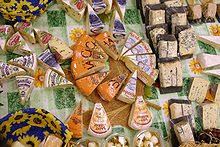
- Fresh
- Whey
- Pasta filata
- Semi-soft
- Semi-firm
- Hard
- Double and triple cream
- Soft-ripened
- Blue vein
- Goat or sheep
- Strong-smelling
- Sharp
- Processed
Fresh, whey and stretched curd cheeses
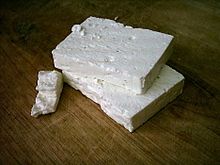
The main factor in the categorization of these cheese is their age. Fresh cheeses without additional preservatives can spoil in a matter of days.
For these simplest cheeses, milk is curdled and drained, with little other processing. Examples include cottage cheese, Romanian Caş, Neufchâtel (the model for American-style cream cheese), and fresh goat's milk chèvre. Such cheeses are soft and spreadable, with a mild taste.
Whey cheeses are fresh cheeses made from the whey discarded while producing other cheeses. Provencal Brousse, Corsican Brocciu, Italian Ricotta, Romanian Urda, Greek Mizithra, and Norwegian Geitost are examples. Brocciu is mostly eaten fresh, and is as such a major ingredient in Corsican cuisine, but it can be aged too.
Traditional pasta filata cheeses such as Mozzarella also fall into the fresh cheese category. Fresh curds are stretched and kneaded in hot water to form a ball of Mozzarella, which in southern Italy is usually eaten within a few hours of being made. Stored in brine, it can be shipped, and is known worldwide for its use on pizzas. Other firm fresh cheeses include paneer and queso fresco.
Classed by texture

Categorizing cheeses by firmness is a common but inexact practice. The lines between "soft", "semi-soft", "semi-hard", and "hard" are arbitrary, and many types of cheese are made in softer or firmer variations. The factor controlling the hardness of a cheese is its moisture content which is dependent on the pressure with which it is packed into molds and the length of time it is aged.
Semi-soft cheeses and the sub-group, Monastery cheeses have a high moisture content and tend to be bland in flavor. Some well-known varieties include Havarti, Munster and Port Salut.
Cheeses that range in texture from semi-soft to firm include Swiss-style cheeses like Emmental and Gruyère. The same bacteria that give such cheeses their holes also contribute to their aromatic and sharp flavors. Other semi-soft to firm cheeses include Gouda, Edam, Jarlsberg and Cantal. Cheeses of this type are ideal for melting and are used on toast for quick snacks.
Harder cheeses have a lower moisture content than softer cheeses. They are generally packed into molds under more pressure and aged for a longer time. Cheeses that are semi-hard to hard include the familiar Cheddar, originating in the village of Cheddar in England but now used as a generic term for this style of cheese, of which varieties are imitated worldwide and are marketed by strength or the length of time they have been aged. Cheddar is one of a family of semi-hard or hard cheeses (including Cheshire and Gloucester) whose curd is cut, gently heated, piled, and stirred before being pressed into forms. Colby and Monterey Jack are similar but milder cheeses; their curd is rinsed before it is pressed, washing away some acidity and calcium. A similar curd-washing takes place when making the Dutch cheeses Edam and Gouda.
Hard cheeses — "grating cheeses" such as Parmesan and Pecorino Romano—are quite firmly packed into large forms and aged for months or years.

Classed by content
Some cheeses are categorized by the source of the milk used to produce them or by the added fat content of the milk from which they are produced. While most of the world's commercially available cheese is made from cows' milk, many parts of the world also produce cheese from goats and sheep, well-known examples being Roquefort, produced in France, and Pecorino Romano, produced in Italy, from ewes's milk. One farm in Sweden also produces cheese from moose's milk. Sometimes cheeses of a similar style may be available made from milk of different sources, Feta style cheeses, for example, being made from goats' milk in Greece and of sheep and cows milk elsewhere.
Double cream cheeses are soft cheeses of cows' milk which are enriched with cream so that their fat content is 60% or, in the case of triple creams, 75%.
Soft-ripened and Blue-vein
There are three main categories of cheese in which the presence of mold is a significant feature: soft ripened cheeses, washed rind cheeses and blue cheeses.

Soft-ripened cheeses are those which begin firm and rather chalky in texture but are aged from the exterior inwards by exposing them to mold. The mold may be a velvety bloom of Penicillium candida or P. camemberti that forms a flexible white crust and contributes to the smooth, runny, or gooey textures and more intense flavors of these aged cheeses. Brie and Camembert, the most famous of these cheeses, are made by allowing white mold to grow on the outside of a soft cheese for a few days or weeks. Goats' milk cheeses are often treated in a similar manner, sometimes with white molds (Chèvre-Boîte) and sometimes with blue.
Washed-rind cheeses are soft in character and ripen inwards like those with white molds; however, they are treated differently. Washed rind cheeses are periodically cured in a solution of saltwater brine and other mold-bearing agents which may include beer, wine, brandy and spices, making their surfaces amenable to a class of bacteria Brevibacterium linens (the reddish-orange "smear bacteria") which impart pungent odors and distinctive flavors. Washed-rind cheeses can be soft (Limburger), semi-hard (Munster), or hard (Appenzeller). The same bacteria can also have some impact on cheeses that are simply ripened in humid conditions, like Camembert.

So-called blue cheese is created by inoculating a cheese with Penicillium roqueforti or Penicillium glaucum. This is done while the cheese is still in the form of loosely pressed curds, and may be further enhanced by piercing a ripening block of cheese with skewers in an atmosphere in which the mold is prevalent. The mold grows within the cheese as it ages. These cheeses have distinct blue veins which gives them their name, and, often, assertive flavors. The molds may range from pale green to dark blue, and may be accompanied by white and crusty brown molds.Their texture can be soft or firm. Some of the most renowned cheeses are of this type, each with its own distinctive color, flavor, texture and smell. They include Roquefort, Gorgonzola, and Stilton.

Processed cheeses
Processed cheese is made from traditional cheese and emulsifying salts, often with the addition of milk, more salt, preservatives, and food coloring. It is inexpensive, consistent, and melts smoothly. It is sold packaged and either pre-sliced or unsliced, in a number of varieties. It is also available in spraycans.
Eating and cooking
At refrigerator temperatures, the fat in a piece of cheese is as hard as unsoftened butter, and its protein structure is stiff as well. Flavor and odor compounds are less easily liberated when cold. For improvements in flavor and texture, it is widely advised that cheeses be allowed to warm up to room temperature before eating. If the cheese is further warmed, to 26–32 °C (80–90 °F), the fats will begin to "sweat out" as they go beyond soft to fully liquid.
At higher temperatures, most cheeses melt. Rennet-curdled cheeses have a gel-like protein matrix that is broken down by heat. When enough protein bonds are broken, the cheese itself turns from a solid to a viscous liquid. Soft, high-moisture cheeses will melt at around 55 °C (131 °F), while hard, low-moisture cheeses such as Parmesan remain solid until they reach about 82 °C (180 °F). Acid-set cheeses, including halloumi, paneer, some whey cheeses and many varieties of fresh goat cheese, have a protein structure that remains intact at high temperatures. When cooked, these cheeses just get firmer as water evaporates.
Some cheeses, like raclette, melt smoothly; many tend to become stringy or suffer from a separation of their fats. Many of these can be coaxed into melting smoothly in the presence of acids or starch. Fondue, with wine providing the acidity, is a good example of a smoothly melted cheese dish. Elastic stringiness is a quality that is sometimes enjoyed, in dishes including pizza and Welsh rarebit. Even a melted cheese eventually turns solid again, after enough moisture is cooked off. The saying "you can't melt cheese twice" (meaning "some things can only be done once") refers to the fact that oils leach out during the first melting and are gone, leaving the non-meltable solids behind.
As its temperature continues to rise, cheese will brown and eventually burn. Browned, partially burned cheese has a particular distinct flavor of its own and is frequently used in cooking (e.g., sprinkling atop items before baking them).
Health and nutrition
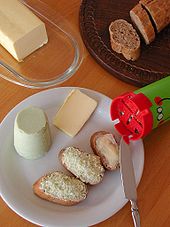
In general, cheese supplies a great deal of calcium, protein, phosphorus and fat. A 30-gram (1.1 oz) serving of Cheddar cheese contains about 7 grams (0.25 oz) of protein and 200 milligrams of calcium. Nutritionally, cheese is essentially concentrated milk: it takes about 200 grams (7.1 oz) of milk to provide that much protein, and 150 grams (5.3 oz) to equal the calcium.
Cheese potentially shares other of milk's nutritional content as well. The Center for Science in the Public Interest describes cheese as America's number one source of saturated fat, adding that the average American ate 30 lb (14 kg) of cheese in the year 2000, up from 11 lb (5 kg) in 1970. Their recommendation is to limit full-fat cheese consumption to 2 oz (57 g) a week. Whether cheese's highly saturated fat actually leads to an increased risk of heart disease is called into question when considering France and Greece, which lead the world in cheese eating (more than 14 oz (400 g) a week per person, or over 45 lb (20 kg) a year) yet have relatively low rates of heart disease. This seeming discrepancy is called the French Paradox; the higher rates of consumption of red wine in these countries is often invoked as at least a partial explanation.
Some studies claim to show that Cheddar, Mozzarella, Swiss and American cheeses can help to prevent tooth decay. Several mechanisms for this protection have been proposed:
- The calcium, protein, and phosphorus in cheese may act to protect tooth enamel.
- Cheese increases saliva flow, washing away acids and sugars.
- Cheese may have an antibacterial effect in the mouth.
Controversy
Effect on sleep
A study by the British Cheese Board in 2005 to determine the effect of cheese upon sleep and dreaming discovered that, contrary to the idea that cheese commonly causes nightmares, the effect of cheese upon sleep was positive. The majority of the two hundred people tested over a fortnight claimed beneficial results from consuming cheeses before going to bed, the cheese promoting good sleep. Six cheeses were tested and the findings were that the dreams produced were specific to the type of cheese. Although the apparent effects were in some cases described as colorful and vivid, or cryptic, none of the cheeses tested were found to induce nightmares. However, the six cheeses were all British. The results might be entirely different if a wider range of cheeses were tested. Cheese contains tryptophan, an amino acid that has been found to relieve stress and induce sleep.
Casein
Like other dairy products, cheese contains casein, a substance that when digested by humans breaks down into several chemicals, including casomorphine, an opioid peptide. In the early 1990s it was hypothesized that autism can be caused or aggravated by opioid peptides. Based on this hypothesis, diets that eliminate cheese and other dairy products are widely promoted. Studies supporting these claims have had significant flaws, so the data are inadequate to guide autism treatment recommendations.
Lactose
Cheese is often avoided by those who are lactose intolerant, but ripened cheeses like Cheddar contain only about 5% of the lactose found in whole milk, and aged cheeses contain almost none. Nevertheless, people with severe lactose intolerance should avoid eating dairy cheese. As a natural product, the same kind of cheese may contain different amounts of lactose on different occasions, causing unexpected painful reactions. As an alternative, also for vegans, there is already a wide range of different soy cheese kinds available. Some people suffer reactions to amines found in cheese, particularly histamine and tyramine. Some aged cheeses contain significant concentrations of these amines, which can trigger symptoms mimicking an allergic reaction: headaches, rashes, and blood pressure elevations.
Pasteurization
A number of food safety agencies around the world have warned of the risks of raw-milk cheeses. The U.S. Food and Drug Administration states that soft raw-milk cheeses can cause "serious infectious diseases including listeriosis, brucellosis, salmonellosis and tuberculosis". It is U.S. law since 1944 that all raw-milk cheeses (including imports since 1951) must be aged at least 60 days. Australia has a wide ban on raw-milk cheeses as well, though in recent years exceptions have been made for Swiss Gruyère, Emmental and Sbrinz, and for French Roquefort. There is a trend for cheeses to be pasteurized even when not required by law.
Compulsory pasteurization is controversial. Pasteurization does change the flavor of cheeses, and unpasteurized cheeses are often considered to have better flavor, so there are reasons not to routinely pasteurize all cheeses. Some say that health concerns are overstated, pointing out that pasteurization of the milk used to make cheese does not ensure its safety in any case. This is supported by statistics showing that in some European countries where young raw-milk cheeses may legally be sold, most cheese-related food poisoning incidents were traced to pasteurized cheeses.
Pregnant women may face an additional risk from cheese; the U.S. Centers for Disease Control has warned pregnant women against eating soft-ripened cheeses and blue-veined cheeses, due to the listeria risk, which can cause miscarriage or harm to the fetus during birth.
World production and consumption
Worldwide, cheese is a major agricultural product. According to the Food and Agricultural Organization of the United Nations, over 18 million metric tons of cheese were produced worldwide in 2004. This is more than the yearly production of coffee beans, tea leaves, cocoa beans and tobacco combined. The largest producer of cheese is the United States, accounting for 30% of world production, followed by Germany and France.
| Top cheese producers (1,000 metric tons) | |
|---|---|
| 4,275 (2006) | |
| 1,927 (2008) | |
| 1,884 (2008) | |
| 1,149 (2008) | |
| 732 (2008) | |
| 594 (2008) | |
| 495 (2006) | |
| 462 (2006) | |
| 425 (2006) | |
| 395 (2006) | |
The biggest exporter of cheese, by monetary value, is France; the second, Germany (although it is first by quantity). Among the top ten exporters, only Ireland, New Zealand, the Netherlands and Australia have a cheese production that is mainly export oriented: respectively 95%, 90%, 72%, and 65% of their cheese production is exported. Only 30% of French production, the world's largest exporter, is exported. The United States, the biggest world producer of cheese, is a marginal exporter, as most of its production is for the domestic market.
| Top cheese exporters (Whole Cow Milk only) - 2004 (value in '000 US $) | |
|---|---|
| 2,658,441 | |
| 2,416,973 | |
| 2,099,353 | |
| 1,253,580 | |
| 1,122,761 | |
| 643,575 | |
| 631,963 | |
| 567,590 | |
| 445,240 | |
| 374,156 | |
Germany is the largest importer of cheese. The UK and Italy are the second- and third-largest importers.
| Top cheese consumers - 2003 (kilograms per person per year) | |
|---|---|
| 27.3 | |
| 24.0 | |
| 22.9 | |
| 20.6 | |
| 20.2 | |
| 19.9 | |
| 19.5 | |
| 17.9 | |
Greece is the world's largest (per capita) consumer of cheese, with 27.3 kg eaten by the average Greek. (Feta accounts for three-quarters of this consumption.) France is the second biggest consumer of cheese, with 24 kg by inhabitant. Emmental (used mainly as a cooking ingredient) and Camembert are the most common cheeses in France Italy is the third biggest consumer by person with 22.9 kg. In the U.S., the consumption of cheese is quickly increasing and has nearly tripled between 1970 and 2003. The consumption per person has reached, in 2003, 14.1 kg (31 pounds). Mozzarella is America's favorite cheese and accounts for nearly a third of its consumption, mainly because it is one of the main ingredients of pizza.
Cultural attitudes
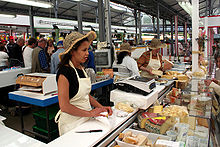
Although cheese is a vital source of nutrition in many regions of the world, and is extensively consumed in others, its use as a nutritional product is not universal. Cheese is rarely found in East Asian dishes, as lactose intolerance is relatively common in that part of the world and hence dairy products are rare. However, East Asian sentiment against cheese is not universal; cheese made from yaks' (chhurpi) or mares' milk is common on the Asian steppes; the national dish of Bhutan, ema datsi, is made from homemade cheese and hot peppers and cheese such as Rushan and Rubing in Yunnan, China is produced by several ethnic minority groups by either using goat's milk in the case of rubing or cow's milk in the case of rushan. Cheese consumption is increasing in China, with annual sales more than doubling from 1996 to 2003 (to a still small 30 million U.S. dollars a year). Certain kinds of Chinese preserved bean curd are sometimes misleadingly referred to in English as "Chinese cheese", because of their texture and strong flavor.
Strict followers of the dietary laws of Islam and Judaism must avoid cheeses made with rennet from animals not slaughtered in a manner adhering to halal or kosher laws. Both faiths allow cheese made with vegetable-based rennet or with rennet made from animals that were processed in a halal or kosher manner. Many less-orthodox Jews also believe that rennet undergoes enough processing to change its nature entirely, and do not consider it to ever violate kosher law. (See Cheese and kashrut.) As cheese is a dairy food under kosher rules it cannot be eaten in the same meal with any meat.
Some vegetarians avoid any cheese made from animal-based rennet. Most widely available vegetarian cheeses are made using rennet produced by fermentation of the fungus Mucor miehei. Vegans and other dairy-avoiding vegetarians do not eat real cheese at all, but some vegetable-based cheese substitutes (usually soy-and almond-based) are available.
Even in cultures with long cheese traditions, it is not unusual to find people who perceive cheese - especially pungent-smelling or mold-bearing varieties such as Limburger or Roquefort - as unappetizing, unpalatable, or disgusting. The most extreme examples are Casu marzu, Milbenkäse and Mimolette. . Food-science writer Harold McGee proposes that cheese is such an acquired taste because it is produced through a process of controlled spoilage and many of the odor and flavor molecules in an aged cheese are the same found in rotten foods. He notes, "An aversion to the odor of decay has the obvious biological value of steering us away from possible food poisoning, so it is no wonder that an animal food that gives off whiffs of shoes and soil and the stable takes some getting used to."
Collecting cheese labels is called "tyrosemiophilia".
In language
In modern English slang, something "cheesy" is kitsch, cheap, inauthentic, or of poor quality. The use of the word probably derived not from the word cheese, but from the Persian or Hindi word chiz, meaning a thing. The word was picked up by British soldiers in Asia minor and came to mean "showy" in English slang from which it came to its modern usage.
A more whimsical bit of American and Canadian slang refers to school buses as "cheese wagons", a reference to school bus yellow. Subjects of photographs are often encouraged to "say cheese!", as the word "cheese" contains the phoneme /i/, a long vowel which requires the lips to be stretched in the appearance of a smile. People from Wisconsin and the Netherlands, both centers of cheese production, have been called cheeseheads. This nickname has been embraced by Wisconsin sports fans – especially fans of the Green Bay Packers or Wisconsin Badgers – who are often seen in the stands sporting plastic or foam hats in the shape of giant cheese wedges.
One can also be "cheesed off" – unhappy or annoyed. A leading authority figure may sometimes be referred to as "the head cheese." Also "Cheese it" is a 1950s slang term that means "get away fast". In Australia, children often refer to their mother as 'the Old Cheese'.
See also
Notes and references
- Notes
- Fankhauser, David B. (2007). "Fankhauser's Cheese Page". Retrieved 2007-09-23.
- Jenny Ridgwell, Judy Ridgway, Food around the World, (1986) Oxford University Press, ISBN 0-19-832728-5
- Vicki Reich, Cheese January 2002 Newsletter,
- History of Cheese. accessed 2007/06/10
- "British Cheese homepage". British Cheese Board. 2007. Retrieved 2007-07-13.
- Quoted in Newsweek, October 1, 1962 according to The Columbia Dictionary of Quotations (Columbia University Press, 1993 ISBN 0-231-07194-9 p 345). Numbers besides 246 are often cited in very similar quotes; whether these are misquotes or whether de Gaulle repeated the same quote with different numbers is unclear.
- Smith, John H. (1995). Cheesemaking in Scotland - A History. The Scottish Dairy Association. ISBN 0-9525323-0-1.. Full text (Archived link), Chapter with cheese timetable (Archived link).
- Cecil Adams (1999). "Straight Dope: How did the moon=green cheese myth start?". Retrieved October 15, 2005.
- McGee, Harold (2004). On Food and Cooking (Revised Edition). Scribner. ISBN 0-684-80001-2. p 54. "In the United States, the market for process cheese is now larger than the market for 'natural' cheese, which itself is almost exclusively factory-made."
- Barbara Ensrud, (1981) The Pocket Guide to Cheese, Lansdowne Press/Quarto Marketing Ltd., ISBN 0-7018-1483-7
- "Moose milk makes for unusual cheese". The Globe and Mail. 26 June 2004. Retrieved 2007-08-27.
{{cite news}}: Check date values in:|date=(help) - Template:Wikiref
- Template:Wikiref
- Template:Wikiref
- Nutritional data from CNN Interactive. Retrieved October 20, 2004.
- Center for Science in the Public Interest (2001). "Don't Say Cheese". Retrieved October 15, 2005.
- McGee, p 67. McGee supports both this contention and that more food poisonings in Europe are caused by pasteurized cheeses than raw-milk.
- National Dairy Council. "Specific Health Benefits of Cheese." Retrieved October 15, 2005.
- The Pharmaceutical Journal, Vol 264 No 7078 p48 January 8, 2000 Clinical.
- Sleep Study, 2005.
- Cheese Facts, I Love Cheese, 2006. .
- Reichelt KL, Knivsberg A-M, Lind G, Nødland M (1991). "Probable etiology and possible treatment of childhood autism". Brain Dysfunct. 4: 308–19.
{{cite journal}}: CS1 maint: multiple names: authors list (link) - Christison GW, Ivany K (2006). "Elimination diets in autism spectrum disorders: any wheat amidst the chaff?". J Dev Behav Pediatr. 27 (2 Suppl 2): S162–71. doi:10.1097/00004703-200604002-00015. PMID 16685183.
- Lactose Intolerance FAQs from the American Dairy Association, Retrieved October 15, 2005.
- FDA Warns About Soft Cheese Health Risk". Consumer Affairs. Retrieved October 15, 2005.
- Chris Mercer (2005). "Australia lifts Roquefort cheese safety ban". Retrieved October 22, 2005.
- Janet Fletcher. "The Myths about Raw-Milk Cheese". Retrieved October 15, 2005.
- Listeria and Pregnancy. Retrieved February 28, 2006.
- United States Department of Agriculture for the US and non European countries in 2006 and Eurostat for European countries in 2008
- Sources: FAO and Eurostat.
- UN Food & Agriculture Organisation (FAO)
- Source FAO
- CNIEL
- Cidilait, Le fromage
- USDA
- Rebecca Buckman (2003). "Let Them Eat Cheese". Far Eastern Economic Review. 166 n. 49: 41. Full text.
- Toronto Public Health. Frequently Asked Questions about Halal Foods. Retrieved October 15, 2005.
- McGee p 58, "Why Some People Can't Stand Cheese"
- Cheese label.
- Michael Quinion (2000). World Wide Words: Big Cheese. Retrieved October 15, 2005.
- "cheesy" Online Etymology Dictionary. Douglas Harper, Historian. 11 Sep. 2008.
- Straight Dope staff report (2005). "Why do photographers ask you to say 'cheese'?". Retrieved October 15, 2005.
- References
- Ensrud, Barbara (1981). The Pocket Guide to Cheese. Sydney: Lansdowne Press. ISBN 0-7018-1483-7.
{{cite book}}: Cite has empty unknown parameter:|unused_data=(help); Text "Lansdowne Press/Quarto Marketing Ltd." ignored (help) - Jenkins, Steven (1996). Cheese Primer. Workman Publishing Company. ISBN 0-89480-762-5.
- McGee, Harold (2004). "Cheese". On Food and Cooking (Revised ed.). Scribner. pp. pp. 51–63. ISBN 0-684-80001-2.
{{cite book}}:|pages=has extra text (help) - Mellgren, James (2003). "2003 Specialty Cheese Manual, Part II: Knowing the Family of Cheese". Retrieved 2005-10-12.
External links
Listen to this article(2 parts, 27 minutes)
- University of Guelph Food Science Cheese Site
- Cheese Making Illustrated — The science behind homemade cheese.
- The Complete Book of Cheese at Project Gutenberg
- Cheese.com — includes an extensive database of different types of cheese.
- Template:Dmoz
- Cheese Guide & Terminology — Different classifications of cheese with notes on varieties.
- Fromagedumois — A U.S.-based Blog about different world cheeses, with an emphasis on region and preparation.
Template:Link FA Template:Link FA Template:Link FA Template:Link FA
Categories: